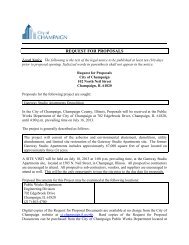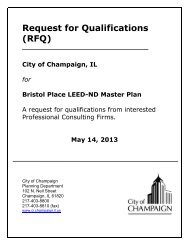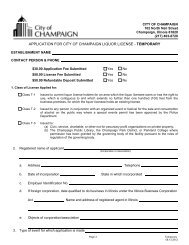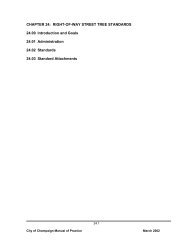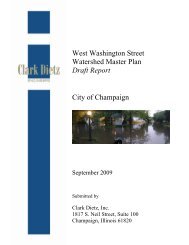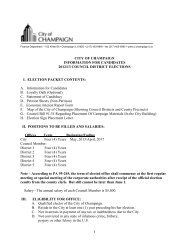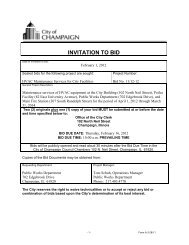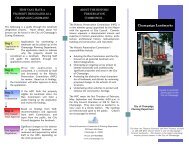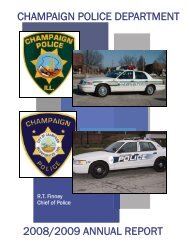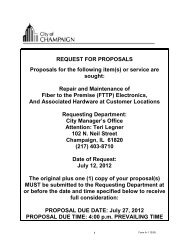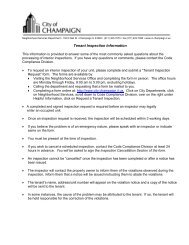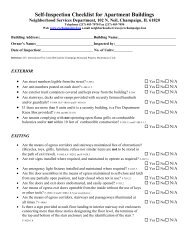2010-2014 Consolidated Plan - City of Champaign
2010-2014 Consolidated Plan - City of Champaign
2010-2014 Consolidated Plan - City of Champaign
Create successful ePaper yourself
Turn your PDF publications into a flip-book with our unique Google optimized e-Paper software.
The development that occurred as a result <strong>of</strong> this effort impacted the character <strong>of</strong> areas containing thesebuildings. Historic properties were demolished and new buildings constructed which were out <strong>of</strong>character in terms <strong>of</strong> style and density. In Downtown <strong>Champaign</strong>, both private and <strong>City</strong> support forrevitalization resulted in the demolition <strong>of</strong> historic buildings and areas that provided physical evidence <strong>of</strong>the culture and character <strong>of</strong> the area. In an effort to maintain local historic properties, the <strong>City</strong> <strong>of</strong><strong>Champaign</strong> was designated as a Certified Local Government by the Illinois Housing Preservation Agency,which allows the <strong>City</strong> to participate in the historic property review process, receive technical assistance,and apply for grants.Neighborhood Preservation<strong>Champaign</strong>'s older neighborhoods are very diverse. Some have a high concentration <strong>of</strong> historicproperties, while in others, historic buildings are scattered throughout the neighborhood. Yet otherspossess a distinctive characteristic or atmosphere worthy <strong>of</strong> preservation, although buildings are notparticularly historic. There are also different land use patterns and redevelopment needs acrossneighborhoods. Downtown <strong>Champaign</strong> is primarily commercial and the preservation <strong>of</strong> historic buildingsis important to its redevelopment. Also important to the success <strong>of</strong> Downtown is the need to facilitateredevelopment <strong>of</strong> the upper floors <strong>of</strong> older commercial buildings for other uses. The In-townNeighborhood is predominantly residential, but only parts are considered truly historic. Other parts arenevertheless unique. The campus area, while predominantly residential, has a high concentration <strong>of</strong>multi-family uses and includes some commercial areas. The campus area also contains a greatconcentration <strong>of</strong> architecturally significant Greek housing.The Historic Preservation ordinance provides for the designation <strong>of</strong> Landmarks (individual structures <strong>of</strong>historic or architectural significance), Historic Districts, and Conservation Districts. Historic Districts areareas containing buildings <strong>of</strong> historic and architectural significance and other important physical attributesincluding lighting, street paving, and streetscape. The emphasis in historic districts is on the preservation<strong>of</strong> the historic character and architectural integrity <strong>of</strong> buildings and areas. Ordinance provisions fordistricts protect the area by requiring design review for alteration, demolition and new construction thatcould impact the district’s historic character. The ordinance allows any person or group to apply for thenomination <strong>of</strong> a district. However, some level <strong>of</strong> owner support for the designation is necessary fordesignation to occur.Conservation Districts characterize areas that possess important physical attributes, and perhaps somehistoric buildings, but would not qualify for historic district designation. Design review is generally lessstringent than in a Historic District and would cover changes that relate to the specific physical featuresthat make the area unique. Only property owners in such areas can initiate the designation process.Generally, the emphasis in the Conservation District is on the conservation <strong>of</strong> neighborhoods bypreserving their unique characteristics.To date, <strong>City</strong> Council has designated twenty-three landmarks, five honorary landmarks, two HistoricDistricts but the potential for further designation is great. Public education efforts (brochures, seminars,and workshops), historic resources surveys, and incentive programs that encourage and rewarddesignation are needed to help promote the benefits designation to residents and property owners.SECTION 4H: PLANNING AND ADMINISTRATIONNEIGHBORHOOD WELLNESS PLANMuch <strong>of</strong> the data that was collected and analyzed on housing value and condition, household incomes,poverty, etc. was used to develop strategies for both the Neighborhood Wellness <strong>Plan</strong> updates and the<strong>Consolidated</strong> <strong>Plan</strong>. The following section provides information on the Neighborhood Wellness <strong>Plan</strong>update process and how it relates to the goals and strategies in the <strong>Consolidated</strong> <strong>Plan</strong>.66 Needs Assessment: Non-Housing Community Development



